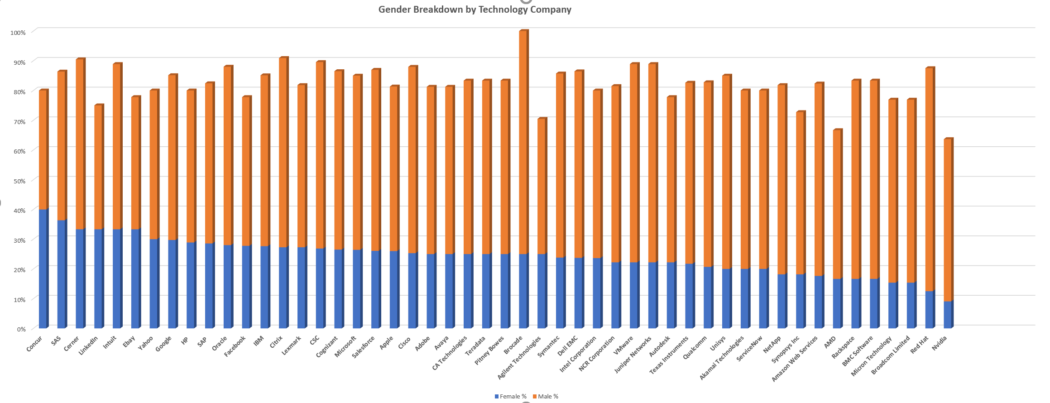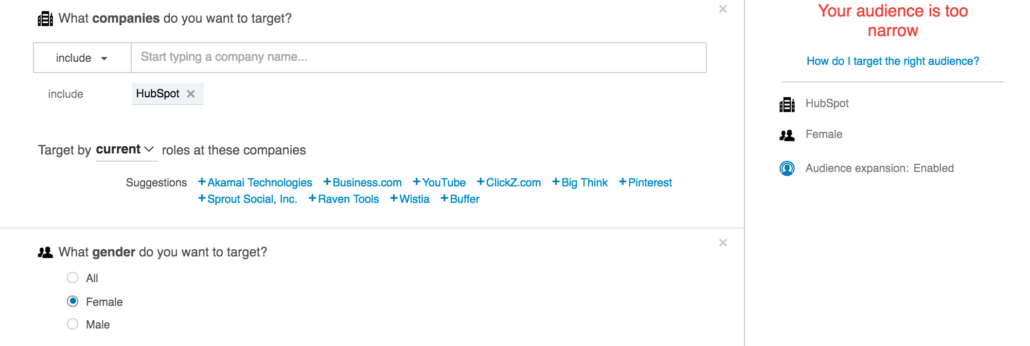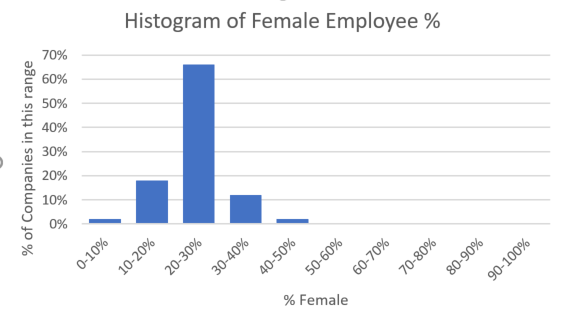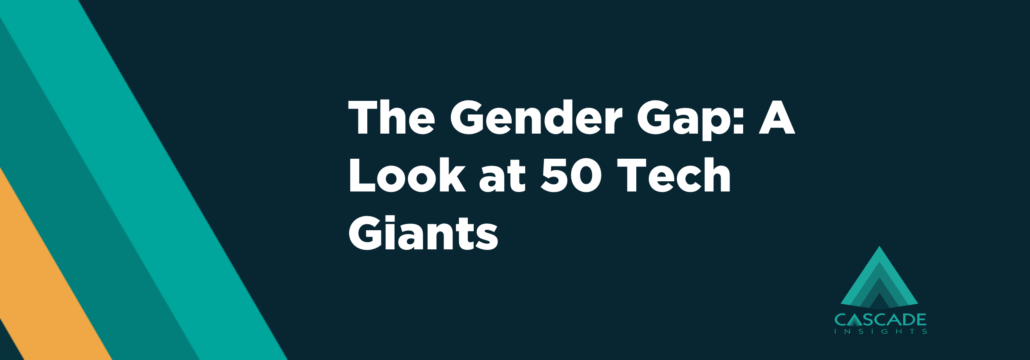LinkedIn ad targeting is a surprisingly useful tool for studying the gender gap in tech giants. Especially in the absence of diversity reports.
This article is based off a B2B Revealed episode.
You can listen to the episode or read the article below.
[sc_embed_player_template1 fileurl=”http://traffic.libsyn.com/competitiveintel/Episode144-GenderStudyInTech.mp3″]
B2B Revealed – ON: iTunes, Stitcher, and Google Play
Gender Gap Generates Headlines
Admittedly, this subject has been widely reported. Major news sites recently ran these headlines:
- “The Rise of Robots Will Make the Tech Gender Gap Even Worse”
- “Sexism in Silicon Valley: the true extent of gender disparity in the tech industry”
- “Does Silicon Valley have a sexism problem?”
- “The gender gap in tech is getting worse but it’s fixable”
- “There Aren’t Enough Women in Tech. Here’s Why.”
However, many articles on the tech gender gap do not include information on the breakdown of gender within major tech companies. Further, when such statistics are cited, they usually come from information companies have released themselves. And the release of diversity reports is not a uniform practice throughout the tech industry.
The Trouble With Relying on Diversity Reports Alone
Companies that share diversity reports release them at different time intervals and with varying metrics.
While searching for diversity reports for companies in our study, we encountered several scenarios. Some companies release annual reports, others less frequently or not at all. Gender percentages are shared only for U.S. employees in some cases while others share data on global workforces. Some companies give only the male/female ratios for new hires.
These differences make it challenging to consistently compare the gender breakdowns of tech companies.
There Must Be A Way
In the absence of recent diversity reports for many major tech companies, we were curious whether there was another way to gather information on the gender breakdown of companies’ global workforces.
LinkedIn allows users to target their ad audiences by many factors including industry, company, and gender. With this tool, we uncovered powerful information on the gender gap in tech.
The Goal of The Study: A Picture, Not a Prescription
The purpose of this study was to find information on gender disparity in tech. Though this is undeniably a politically loaded issue, our objective was to study, not to editorialize.

Methodology
For this study, we selected 50 large tech companies, most of which made the Fortune 1000.
Normally, LinkedIn doesn’t allow users to search by gender. However, users have access to all sorts of audience targeting tools once they draft an ad.
LinkedIn Ad Targeting Data
It’s quite simple to pull data on the female and male employee estimates for companies.
First, we created a draft text ad to use as a placeholder to get to the audience targeting tool. Targeting data is available without purchasing or publishing an ad.
For each company, we found the estimated number of the:
- Total company workforce on LinkedIn.
- Female employees of each company with LinkedIn profiles.
- Male employees of each company with LinkedIn profiles.
Data for this study was collected Feb. 28-March 1, 2017.
A Massive Data Set
LinkedIn ad targeting gave us a much larger sample than used in most corporate research we’ve come across.
For the 50 companies in the study, LinkedIn ad targeting could determine gender for roughly 1.839 million employees. (We arrived at this number by adding together the total male and female estimates for all 50 companies.)
First Name Inference
LinkedIn states that gender is “inferred in English from first name of member.”
This practice is not unique to LinkedIn. While companies use a variety of methods to identify gender at scale, first name determination is a common one. Solutions such as Genderize.io, GenderPredictor, SexMachine and Beauvoir rely on first names to identify gender.
Initially, we were concerned that there could be a potential bias toward assigning gender to predominantly English names. But when we checked our results against recent diversity reports, the targeting data was pretty close to the reported gender ratios. For this reason, we did not investigate English name bias further for this study.
Finding The Data
Though LinkedIn gives several options for ad audience targeting, we used current company and gender.
LinkedIn gives audience estimates for total workforce, male employees, and female employees rounded to the nearest thousand.
For example, the target audience of female Facebook employees on LinkedIn was estimated at “5,000+”. We used the number 5,000 as the female employee estimate for Facebook in our study.

Companies In Our Study Had To Have Thousands of Employees
LinkedIn gives the message “your audience is too narrow” when it estimates an audience to be less than a thousand. That is why we only included companies with thousands of employees in this study.

Gender Unknown Profiles & Ratios
We also considered how the total male and female estimates compared to the total company estimates on LinkedIn. Of the 50 companies we looked at, male and female estimates represented an average of 82 percent of the total company estimates on LinkedIn. Meaning, LinkedIn could not determine the gender of an average of 18 percent of the company’s employees with LinkedIn profiles.
Female employee estimates were drastically lower than male estimates for most of the companies we looked at. So, it was unlikely that the names LinkedIn could not assign a gender to would significantly alter the male/female ratio in all but a few instances. For example, Concur and SAS.
Of the 50 tech companies in our study, Concur and SAS had the highest estimated percentage of female employees in their workforce. Concur was the only company to have equal male and female employee estimates, though LinkedIn was unable to identify a gender for 20 percent of the Concur employees with LinkedIn profiles.

Women Still A Minority In Major Tech Companies
Here are some of our findings:
- On average, women represented 24 percent of their workforces. Men represented 58 percent of their workforces on average. An average of 18 percent of the workforce was gender unknown.
- Women made up only 20-30 percent of the workforce for most of the companies we studied.
- Not one of the companies we studied had higher than a 50 percent or higher estimates for women in the workforce.

Gender unknown LinkedIn profiles could shift the male/female ratios. However, in most cases, it is unlikely the change would be drastic unless all the unassigned profiles were women.
Checking Our Work
Comparing Our Data To Diversity Reports
To check the validity of our LinkedIn ad targeting data, we searched for publicly available gender breakdowns for each company.
We found a publicly released gender breakdown of the global workforce for 20 out of the 50 companies we examined. While many of the other companies had released diversity reports, some were older than 2015, some did not state what year gender data was from, others did not include a gender breakdown or only included gender breakdowns for their U.S. workforces or new hires. We did not consider such reports to be valid comparisons for our LinkedIn ad numbers.
For the 20 companies that did have publicly available gender breakdowns of their global workforces, we found that our LinkedIn ad data yielded very similar ratios.
The average difference between the publicly reported female percentage of the workforce and the one we found through LinkedIn ad targeting was 4 percent.
Spot-checking LinkedIn Ad Targeting In a Female Dominated Industry
We also wanted to test LinkedIn ad data in a different industry, preferably one considered female-dominated. Health care came to mind. So we pulled LinkedIn ad targeting data on gender breakdowns for 12 of the largest hospital systems in America. LinkedIn ad targeting reflected that women consistently represented the majority of the workforce in those 12 hospital systems.
Is There a Huge Gender Disparity For LinkedIn Users In General?
We looked into LinkedIn user demographics as well, to see whether a large gender disparity of the platform’s users could throw off our results. That did not appear to be the case. In 2014, LinkedIn announced that 44 percent of its members were female.
Caveats
According to LinkedIn ad targeting, an estimated 45 million members work in high tech, making it the second most well-represented industry category on LinkedIn.
This methodology is not as valid a source of information for industries where employees are less likely to have LinkedIn profiles.
Further, this methodology is most useful when trying to gain a “big picture” of a group of companies, such as the percentage of male and female employees. It is not as helpful for getting precise number counts of workforce demographic groups, as LinkedIn can only generate estimates based on employees with LinkedIn profiles rounded to the nearest thousand.
Total accuracy on the breakdowns of gender in technology companies would require a census. When relying on publicly available information, there is no meaningful way to do a census of this population. This methodology extends available data on the gender gap more so than solely relying on diversity reports.
Methodology Moving Forward
LinkedIn ad targeting proved to be worthwhile proxy data in this instance.
As a market research firm constantly studying the B2B tech field, this was a valuable find for us. At Cascade Insights, we already leverage LinkedIn quite a bit for corporate research study participant recruiting. It’s great to find that LinkedIn is also a powerful tool for market research in its own right.
Soon, we will be looking at ageism in tech to test this methodology further. [You can see that study here.]
A Useful Research Tool
We wanted to learn whether LinkedIn ad targeting was a valid source of information in the absence of publicly released data on large technology companies’ workforces. Studying gender disparity allowed us to test that.
Takeaways:
- LinkedIn ad targeting for large technology companies yields a huge data set.
- This methodology can be applied consistently, even in the absence of a diversity report.
- These are broad estimates only. Gender data is generated only from employees with LinkedIn profiles. Audience estimates are rounded to the nearest thousand.
- This methodology is only of use for studying companies with workforces in the thousands and target demographics of a thousand or more.
- Assessing the validity of this data was dependent on being able to check it against accurate, publicly available information. In this case, the 20 companies that released the percentage of male and female employees of their global workforce in a report from 2015 or sooner. LinkedIn ad targeting is not a “silver bullet.” It requires cross-checking against other data sets. It is proxy data, but valuable proxy data.
This methodology opens numerous possibilities for insight into the demographics of the technology industry and large tech companies. LinkedIn ad targeting is an empowering tool for market researchers, competitive intelligence teams, marketers, product managers, sales teams, journalists, and more.
This study was brought to you by Cascade Insights, a market research & marketing firm specializing in the B2B tech sector.

